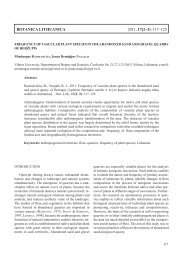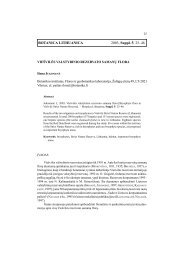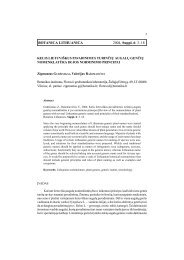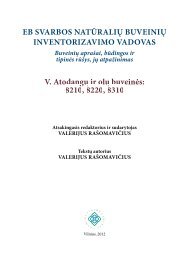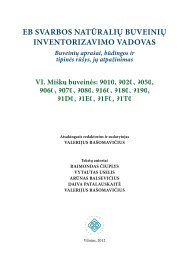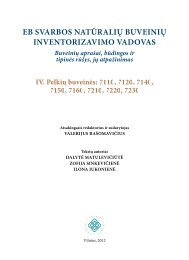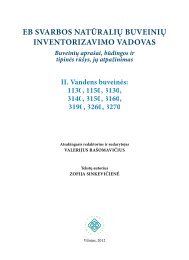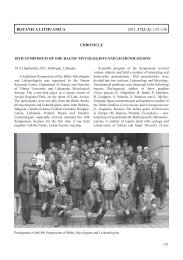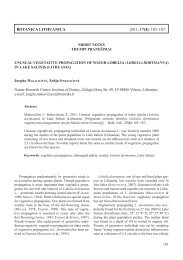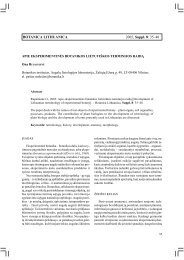FUNGI AND LICHENS IN THE BALTICS AND BEYOND XVIII ...
FUNGI AND LICHENS IN THE BALTICS AND BEYOND XVIII ...
FUNGI AND LICHENS IN THE BALTICS AND BEYOND XVIII ...
Create successful ePaper yourself
Turn your PDF publications into a flip-book with our unique Google optimized e-Paper software.
from such a site, Fredriksbergs mining area, will be reported and discussed. The rarely found<br />
lichen Rhizocarpon furfurosum restricted to copper containing minerals will be also<br />
discussed. One concern is that such areas are eventually covered with vegetation and the<br />
lichens on the rocks disappear then. It means that such areas are in great need of protection<br />
and management.<br />
Another interesting aspect is the chemistry. Iron and especially copper are toxic to<br />
most organisms at least when present in excess. There is an interesting question why they can<br />
manage to live on such substrates. Many of these lichens seems also be depending on<br />
relatively high concentrations of these metals. In the literature very little has been discussed<br />
about the mechanism behind this tolerance to toxic metals. However it is proposed that the<br />
secondary metabolites in the lichen thallus may be the answer to this question. These usually<br />
phenolic substances can immobilize metal ions and bring down the free concentrations to<br />
tolerable levels.<br />
MYCOTOX<strong>IN</strong>S <strong>IN</strong> <strong>THE</strong> RE<strong>IN</strong>DEER <strong>LICHENS</strong><br />
G. P. KONONENKO, A. A. BURK<strong>IN</strong><br />
All-Russian Research Institute for Veterinary Sanitation, Hygiene and Ecology<br />
Zvenigorodskoe shosse 5, Moscow 123022, Russia<br />
E-mails: kononenkogp@mail.ru, aaburkin@mail.ru<br />
Assemblages of diverse filamentous fungi are the integral part of many lichen<br />
organisms (Arnold et al., 2009) but their metabolic profile is still largely underexplored. By<br />
the usage of enzyme-linked immunosorbent assay (ELISA) we revealed mycotoxins – specific<br />
metabolites of free-living fungi of genera Aspergillus, Penicillium, Alternaria and Fusarium –<br />
in “reindeer moss” extracts and supposed that toxigenic fungi were the actual licheninhabitants<br />
(Burkin, Kononenko, 2010, 2011). The purpose of this study was to evaluate the<br />
occurrence of mycotoxins in the lichens Cladonia stellaris (Opiz) Pouz et Vězda, C.<br />
rangiferina (L.) F.H. Wigg., C.arbuscula (Wallr.) Flot., C. mitis Sandst., Cetraria islandica<br />
(L.) Ach. and Allocetraria nivalis (L.) Randl. et Saag. A total of 228 thallus samples were<br />
collected from the expansive territories of the Russian European North (Murmansk region,<br />
Karelia, Laplandskii zapovednik, Pechoro-Ilychskii zapovednik), the south of Tver region,<br />
Taimyr district and some of them were divided into low (aged) and high (young) fragments<br />
before analysis.<br />
All species were shown to be similar in the mycotoxin composition. High percentage<br />
of samples contained emodin (89–100%), sterigmatocistin (80–100%), alternariol (61–100%)<br />
and mycophenolic acid (46–100%). Less frequency was observed for diacetoxyscirpenol (21–<br />
61%) and citrinin (9–61%). Low appearance of other fungal metabolites – cyclopiazonic acid,<br />
ergoalkaloids and PR toxin was predominatingly occurred in a few territories or aged lichen<br />
tissues. Deoxynivalenol, zearalenone, fumonosins, ochratoxin A were very sporadically<br />
detected. Mycotoxins were present in amounts not exceeding 0.005% of the air-dried thallus<br />
weight. Wide ranges of concentrations were established for emodin (33–50120 ng/g),<br />
sterigmatocistin (6–1050 ng/g) and alternariol (20–4898 ng/g). All these data can be regarded<br />
as evidence of the interaction of uniform multi-component complex of toxigenic fungi with<br />
various ecophysiological factors and may be its competition with other lichen-associated<br />
microorganism. Mycotoxins were also detected in herbarium samples and consequently could<br />
be preserved in the lichens for a very long time (Burkin et al., 2011, in press).



